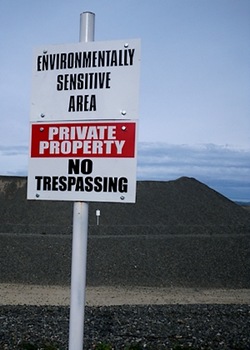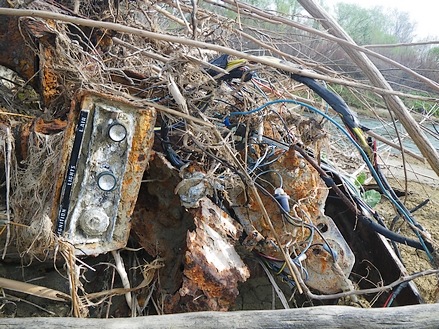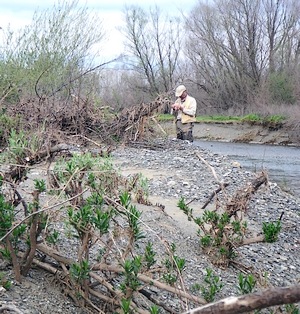 You can’t fault them as it’s worked well for the environmentally conscious types.
You can’t fault them as it’s worked well for the environmentally conscious types.
Stop the creek with a well placed cork, extinct everything but ATV hellions and gravity donations from the housing dispossessed – and when no one’s looking – slap up new signs to keep out the dog walkers and environmentalists.
Are they worried someone will destroy the perfection of their mounded symmetry?
The latest batch of signs that surround a couple billion pounds of spawning gravel excavated out of the surroundings of my newly dampened – dirty little creek.
… soon to be part of your driveway or that subdivision up the road that’s dampening the resale value of your home – due to jinglemail and foreclosure.
It’s one of many changes I logged while tromping through the underbrush this weekend, part of the yearly Spring ritual which maps the newly deepened, the undercut, and the shallow.
… and the living, although there’s not much of that left.
Saturday yielded two turtles lounging in the shallows, away from the sterile scour of the main stem – proof that some of the larger life had made it through the de-watering and subsequent flood.

Old cars being a lifeform of a sort, and most are disgorging their contents independently of the chassis. This old Chevy moved a couple dozen feet closer to the Sacramento, complements of the root ball it has created.
I managed to sting one bass up at the Siphon hole, and the departing ripples suggested at least a pair of carp remained from the school that inhabited the area last year, so some small brood stock remains.
There are no minnows in the shallows, nor fry of any type.
 Benthic drift suggests the smallest insects repopulate first, and the larger organisms follow. This may be why the watershed is dominated by Trico’s – who have yet to stage an appearance.
Benthic drift suggests the smallest insects repopulate first, and the larger organisms follow. This may be why the watershed is dominated by Trico’s – who have yet to stage an appearance.
All algae and weeds are limited to the secondary channels which are typically dry by June. New growth is readily apparent and I stomped through the dense sections to assist Mother Nature in releasing plenty of algae and sprouted growth to repopulate the sterile sections downstream.
Sunday it was the upper stretch of the river, which had been completely dry last year. The creek is running about four times normal, so crossing the main channel required trepidation and tree limbs morphed into wading staff.
No sign of fish or weeds apparent, drastic bank removal complements of the earlier flood, and the bottom cobble covered with a thin layer of brown algae.
Much of the willow growth has been sheared cleanly, evidence of the flood’s ferocity.
What’s left is being eaten by those beaver that survived, and the ample tracks in the drying mud suggested numerous survivors.
After covering nearly five miles of creek in two days and finding visual evidence of fish in only a single spot, things look grim. It’s not unexpected, and the increased flow likely hides additional detail, but it will be some time before anything more than casting practice is offered.
Tags: rebirth of the Little Stinking, turtle, largemouth bass, grass carp, fly fishing, brownlining

Sorry to hear this! I hope there is other water close by that has fish you can harass!
Sorry Keith, sure hope they make a recovery… though given the flow-regimes you’ve described, it will be a tough go, long term.
Hope you can find some other water nearby the house to tug some lips.
Those vile individuals/corporation who are despoiling the Little Stinky will be surprised at her return! The Suds shall rise again!
I’m pullin’ for you both.